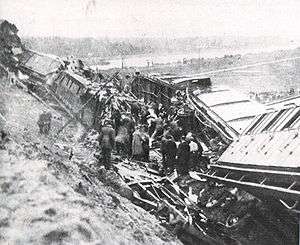Weesp train disaster
The Weesp train disaster took place on 13 September 1918 near Weesp in the Netherlands.[1] With 41 deaths and 42 injured, it was the largest train disaster in Dutch railway history until 1962 when the Harmelen train disaster occurred.
| Weesp train disaster | |
|---|---|
 Damage after the Weesp train disaster | |
 | |
| Details | |
| Date | 13 September 1918 |
| Location | Weesp, North Holland |
| Country | Netherlands |
| Line | Amsterdam–Zutphen railway |
| Operator | Hollandsche IJzeren Spoorweg-Maatschappij |
| Incident type | Derailment |
| Cause | Embankment collapse |
| Statistics | |
| Trains | 1 |
| Deaths | 41 |
| Injured | 42 |
The 102 train from Amersfoort to Amsterdam derailed near the railway bridge over the Merwedekanaal near Weesp and dropped off the bank. Various wooden carriages were splintered, causing many casualties in them.
Composition
The train was composed of two parts; the front carriages came from Zwolle and the rear ones from Enschede. In Hilversum another carriage was hooked on, making a total of 11 carriages, which were pulled by the locomotive HSM 520. The departure time was 9:46 from Amersfoort and 10:10 from Hilversum. According to the schedule the train should have arrived in Amsterdam at 10:40.
The disaster
While ascending the slope of Weesp station towards the bridge over the Merwedekanaal the dike subsided over a length of 95 metres.[1] This was caused by extensive rain in the preceding time[2] and the poor state of repair of the railway dike. At the moment of the subsidance the locomotive was already on the bridge and thus entangled in the ironworks of the bridge construction. The locomotive and tender flipped to the right. The tender lay on the bridgehead, a luggage wagon next to it came to a standstill against the bridgehead. The following three carriages slid off the slope and shoved into each other. The wooden upperside was largely splintered, causing the most casualties. The third carriage was also engulfed by the luggage carriage on the rear and a postal carriage, which because of the speed partially ended up next to the forward carriages. The carriage behind the postal carriage ended up skewed down from the slope, but was barely damaged. The rear carriages of the train derailed but remained on the tracks.
Emergency aid
The disaster happened at 10:25. Two minutes before a train from Amsterdam to Hilversum passed. The station chief of Weesp station sounded the alarm at 10:45. A surgeon who happened to be on the train took care of first aid, soon assisted by two doctors rushed in from Weesp. Four nuns also gave aid, as well as soldiers who happened to be in the neighbourhood. There were no victims among the train crew, who also helped shortly after the disaster.
At 11:40 the first aid train arrived from Naarden-Bussum followed by accident carriages and carriages for transporting injured from Amsterdam. After that a Red Cross train arrived. At 12:40 the first injured and non-injured passengers were able to leave for Amsterdam. About 2 1/2 hours after the disaster the first injured arrived on an aid train at Muiderpoort station in Amsterdam and were transferred to the Onze Lieve Vrouwe Gasthuis hospital. Two ships which were sailing on the Merwedekanaal were stopped and they transported injured to the Binnengasthuis in Amsterdam. At 13:30 a tug left with two ships and 36 injured for Amsterdam; half an hour later a ship carrying 32 corpses followed, which arrived at the Wilhelmina Gasthuis at 16:00.
Rerouting of train traffic
The trains between Amsterdam and Amersfoort were temporarily rerouted through Breukelen and Utrecht. For commuter traffic there were several trains from Naarden-Bussum through Hilversum and Utrecht to Amsterdam. Six days after the disaster, rail traffic resumed over one track with a maximum speed of 5 km/h.[3] After the bridge and dike were repaired both tracks were fully available again on 2 December.
Investigation
The day after the disaster an investigative commission was instituted under the chairmanship of minister Lely. The investigation concluded that the embankment had been soaked by a prolonged period of rainfall.[1] This was aggravated by the structure of the dike which featured impenetrable layers that the water could not escape through. Also the percolation water from the Merwedekanaal seeped through the loam dikes. The ground water level in the railway dike had therefore risen above ground level. As a result of the passing of the train the embankment vibrated and the more or less liquified dike collapsed and was shoved aside.
The disaster instigated the founding of the Laboratorium voor Grondmechanica at the Technische Hogeschool in Delft.
Later train accident near Weesp
On 19 June, 1953, two passenger trains collided near Weesp, causing at least 2 deaths.[1]
References
- "Ook in 1918 treinramp bij Weesp". Nieuwsblad van het Noorden (in Dutch). June 19, 1953. p. 2. Retrieved December 8, 2011.
- "Serious Railway Disaster". Chippewa Herald-Telegram. Chippewa Falls, WI. 16 September 1918. p. 2 – via Newspapers.com.

- "Onder de streep". Algemeen Handelsblad (in Dutch). September 19, 1918. p. 5. Retrieved December 8, 2011.
Bibliography
- Op de Rails, 1968-10 (in Dutch). p. 223. ISSN 0030-3321.
- Jongerius, R.T. (1993). Spoorwegongevallen in Nederland, 1839–1993 (in Dutch). Haarlem: Schuyt & Co. ISBN 90-6097-341-0. Part 22 in the book series by the Nederlandse Vereniging van Belangstellenden in het Spoor- en tramwegwezen.
External links
- 10 Most Dramatic Vintage Railway Bridge Disasters
- (in Dutch) Spoorwegongeval Weesp 1918 - on nicospilt.com with various photos, clippings and stories
- (in Dutch) Photos of the Weesp train disaster on the site of the Beeldbank Amsterdam